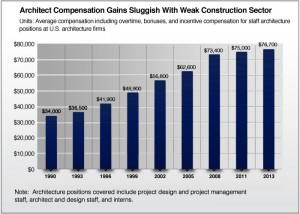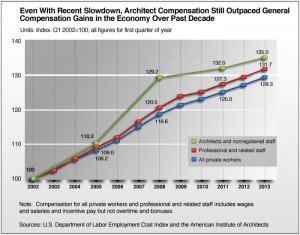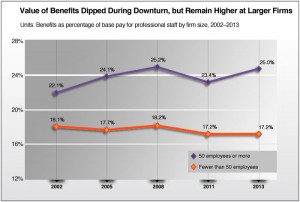By Nate Berg
From entry-level interns to top-tier management, the business of architecture relies on smart workers [staff]. To stay competitive and endure an ever-turbulent job market, design firms need to recruit the best and the brightest while holding on to the skilled talent they already have.
Look for Inquisitive Minds
When seeking new talent, New York–based Robert A.M. Stern Architects partner Graham Wyatt, AIA, says firms should look broadly at the candidates’ talents. Architectural ability and design skills are obviously important, but they shouldn’t be the only factors considered. “Look for people who are broadly educated and, beyond that, people who are inquisitive about the world, who are not just one-dimensional,” he says.
Incentive High Performance
Rewarding employees based on the quality of their work will push them to excel and make them feel appreciated. Robert A.M. Stern Architects uses a system as part of a profit-sharing model that, when the firm is in the black, issues an additional bonus to employees based on annual reviews. “The principle of it is important to the culture of our firm, which is to reward people at all levels so they feel that they’re pulling in the same direction,” Wyatt says, “and that’s really essential to our success.”
Respond to Shifts in Supply and Demand
The layoffs during the recession may seem like fresh wounds, but the market has recovered. Demand for architects is high now due to increased work and a limited supply of professionals. “Twenty to 30 percent of the architectural workforce left in the last recession, so the talent pool is much smaller,” says David McFadden, CEO of Consulting for Architects, a staffing agency. Firms need to recognize that it’s a seller’s market. “Architects are just not sitting on a department store shelf anymore.”
Evaluate Routinely
Regular performance reviews are crucial for employers to track progress and for workers to get positive feedback, constructive criticism, and, ideally, a chance to request a raise. Communication is mutually beneficial, but it sometimes doesn’t happen enough. “In some firms, the annual review only happens every two or three years,” says Herbert Cannon, president of consultancy AEC Management Solutions. “That can be demoralizing to employees.”
Be Less Picky, Hire More Quickly
A dearth of architects means employers need to adjust expectations and perhaps lower their hiring standards. The perfect candidate simply might not exist. “There’s still this perception that there’s people available that meet all of your criteria. But in fact there’s not and so you need to make a quick attitude adjustment,” says McFadden. To top it off, the limited supply is in such demand—the candidates you want may be under consideration by other firms. McFadden suggests acting quickly: “Shorten the time from receiving a résumé to scheduling an interview to making an offer. … You have to be quick; otherwise you’re going to lose out to a firm that is.”
Honor Loyalty
Firms need to know how to hold on to what they’ve got. That was easier during the recession when many architects were happy to have any job. But now that things have turned around and opportunities are opening up, employers need to do more to keep their workers from perusing the job boards. McFadden says firms should increase compensation for the people who stuck with them during the recession, and even more so for those who saw years pass by without a raise.
by Nate Berg for Architectmagazine.com*
*This article was not written for The CFA Blog. This article was written for Architect Magazine.com and reposted by CFA for the CFA Blog.
Editors note: Obviously, we contributed to this article, and agree with the points Nate makes. Do you agree that the hiring trend favors the applicants?
Search Careers
Request Talent
Join Mailing List
Architecture Hiring
|
AIA NY, American Institute of Architects, Architect, architects, architecture, Architecture billings index, business, Consulting For Architects, David McFadden, Hiring Demand, jobs, RAMSA, recession, Rewarding Employees, Robert A.M. Stern Architects, Salary Increase, Staff, Staff Retention, unemployed architects
|

Architecture salaries increase
and the job market is on fire.
Review our current job listings
| Project Architect | Corporate Interiors |
New York |
| Space Planner | University |
New York, New York |
| Assistant Construction PM | Hi-End Residential |
New York, New York |
| Business Development l Project Manager |
Bend, Oregon |
| Senior Interior Designer | Corporate Interiors |
New York, New York |
| Senior Design Architect | Hi-End Residential |
Miami or NY, Florida |
| Senior Technical Architect or Job Captain l Multiple Project Types |
Santa Monica, California |
| Technical and Design Architect | Multiple Projects |
Santa Monica, California |
| Technical Coordinator | Hospitality/Corporate |
New York, New York |
| Senior Interior Designer | Commercial Interiors |
New York |
| Project Manager | Commercial Interiors |
New York, New York |
| Intermediate/Senior Project Manager | Corporate Interiors |
New York, New York |
| Principal Technical Architect | Commercial Interiors |
New York City, New York |
| Intermediate Interior Designer l Multi-Family Residential |
Los Angeles, California |
| Construction Cost Estimator | Mixed-Use. Commercial, Residential |
Los Angeles, California |
| Project Manager | Multi-Family Housing |
New York, New York |
| Intermediate Architectural Lighting Designer |
New York, New York |
| Project Architect | Global Commercial/Global Retail |
Santa Monica, California |
| Intermediate Project Architect | Retail or Hospitality |
New York, New York |
| Project Architect | Retail |
New York, New York |
| Mid-Level Project Architect | Affordable Housing |
New York, New York |
| Junior Designer / Architect | Luxury Retail |
New York, New York |
| Mid Level Interior Designer | Workplace Interiors |
Westwood, Massachusetts |
| Intermediate Architect | Residential and Commercial |
New York |
| Project Architect / Workplace Strategist | Corporate Interiors |
New York, New York |
| Mid-Level Project Architect | Transportation / Infrastructure |
New York, New York |
| Mid-Level Interior Designer | Workplace Interiors |
New York |
| Intermediate or Senior Architect | Zoning Analysis |
NewYork, New York |
| Architects. Designers. Revit. Talent Bidding War. |
New York, New York |
| Marketing Director & New Business Development |
New York, New York |
You can also explore our future opportunities.If you don’t see a current opportunity listed that interests you, reach out to our recruiters and share what you are looking for in your next company. We may have an opportunity that’s not listed above. Send your resume and samples to [email protected]
You can also explore our future opportunities: Create Job Agent Instructions. Create here.
Featured Jobs
|
AIA NY, American Institute of Architects, architects, architecture, Architecture billings index, AutoCAD, Autodesk, commercial, Consulting For Architects, Corporate Interiors, David McFadden, Employment, Freelancers Union, interior designer, intermediate architect, intern architect, job captain, junior architect, project architec, project manager, retail, Revit, senior architect, space planner, unemployed architects
|

Recruiter Kristi Enigl
 Consulting For Architects, Inc. (CFA), a leading staffing firm for the architecture and interior design industry since 1984, announced today the hiring of Recruiter Kristi Enigl located in the New York office.
Consulting For Architects, Inc. (CFA), a leading staffing firm for the architecture and interior design industry since 1984, announced today the hiring of Recruiter Kristi Enigl located in the New York office.
Consulting for Architects (CFA) is pleased to welcome its newest member, Recruiter Ms. Kristi Enigl. CFA has been recruiting talented architects and interior designers since 1984 and placing them in long-term roles with top architectural and design companies throughout the United States. Their latest team member, Ms. Enigl, holds a Bachelor of Arts in Telecommunications from San Diego State University, and for the past two decades has served as senior recruiter and account manager, HR manager and career consultant for staffing firms and architectural companies alike.
For the original version on PRWeb visit here.

Lingering impact from the Great Recession slows gains in salaries
Over the last several years, most architecture firms have benefited from a general improvement in the economy as well as in the construction sector. Revenue at architecture firms increased almost 11 percent in 2012 from 2011 levels, according to U.S. Census Bureau figures, and firm payrolls have followed suit. But this modest improvement in business conditions has done little to lift compensation levels at firms. Between 2011 and 2013, average total compensation for architecture positions—including base salary, overtime, bonuses, and incentive compensation—increased only slightly over 1 percent per year, barely more than the average increase in compensation between 2008 and 2011, when the construction sector was still in steep decline.
Even this modest 1 percent increase in average architect compensation may overstate the experience of the typical architect during this period. Average compensation depends on the mix, by experience levels, of positions reporting. Since many less experienced architecture positions were eliminated during the downturn, current average compensation may reflect a higher share of more experienced (and more highly compensated) positions. Regardless, while average compensation for architecture positions increased a mere 0.7 percent per year compounded between 2008 and 2011, growth increased to only 1.1 percent per year between 2011 and 2013 (Exhibit 1.1).

Architecture staff compensation tends to be more volatile over the business cycle than compensation for most other occupations. Over the past decade, compensation gains for architecture positions have more than kept pace with compensation across the entire economy. Architecture compensation increased 35 percent between early 2002 and early 2013, compared to just under 32 percent for all professional and related staff (typically defined as white-collar workers such as lawyers, accountants, etc.), and just over 29 percent for all private-sector workers (Exhibit 1.2).

Compensation levels vary by firm size
Historically, large architecture firms have offered higher levels of compensation. These comparisons are more difficult for more senior positions because job responsibilities are difficult to compare across firms of different sizes. However, this disparity exists even for positions with relatively standard job descriptions such as Intern 1 or Architect 1.
At firms with fewer than 10 employees, Intern 1 compensation averaged 10 to 15 percent below national averages. At firms with more than 250 employees, Intern 1 compensation averaged more than 10 percent above the national average. A similar pattern held for Architect 1 positions: about 10 percent below the national average at firms with fewer than 10 employees, and almost 10 percent above the national average at firms with 250 or more employees.
Staff turnover and fringe benefits reflect improvement
Another sign that business conditions have stabilized across the profession is that benefits offered to employees have begun to modestly improve at many firms. While declining between 2008 and 2011 as firm revenues eroded, they rebounded modestly by 2013, with benefits packages averaging 18 percent of base salaries for professional staff. Benefits have bounced back faster at larger firms and remain significantly higher than those offered by smaller firms (Exhibit 1.3).

Recent Related:
AIA Compensation Survey: Architect Compensation Stagnant
Reference:
Purchase the 2013 AIA Compensation Report
New for 2013: Architect Compensation by Metro Area
Back to AIArchitect August 9, 2013
Go to the current issue of AIArchitect
Architecture Practice
|
aia, AIA NY, American Institute of Architects, architecture, Architecture billings index, Base Salaries, business, Compensation, economy, Great Recession, jobs, recession, Revenue, U.S. Census Bureau, unemployed architects
|

A New York City Council committee has approved a modified version of a plan to add four new buildings to New York University in Greenwich Village.
The Land Use Committee voted 19-1 Tuesday in favor of a 1.9-million-square-foot expansion plan.
The proposal was reduced about 20 percent since it was presented to a public hearing on June 29.
NYU Senior Vice President Lynne Brown said the plan will help New York City remain economically vibrant.
Council member Margaret Chin, who represents the district, said NYU made significant concessions in its modified proposal.
But Andrew Berman of the Greenwich Village Preservation Society called the downsizing a drop in the bucket.
The full City Council vote is expected on July 25.
Via NY Post
architecture, architecture jobs, Hiring trends, jobs, modern architecture, modern buildings, new buildings, recession, Urban Planning
|
AIA NY, architecture, jobs, unemployed architects
|

When: 12:00 PM – 2:00 PM WEDNESDAY, JANUARY 26
Where: At The Center
AIA New York Chapter
536 LaGuardia Place
NY, NY 10012
(212) 683-0023
This panel discussion will take a look at what architects might expect in terms of employment and workforce trends this year.
Speakers: David C. McFadden, Founder/CEO of Consulting for Architects, Inc. and Daniel A. Cloke, President, Parade A|E|C Staffing
The economy has changed radically throughout the world and the impact has been strongly felt in the design community in New York City. The NBAU program focuses on what design professionals need to do now for themselves and their firms.
Please RSVP as a light lunch will be served. Check local weather report for snow forecast.
Events in this series are provided at no cost thanks to our sponsors: Chief Manufacturing, Lutron Electronics and Skidmore, Owings & Merrill, LLP
Register
aia, architects, architecture, CFA Freelancer Community, Consulting For Architects, David McFadden, Hiring trends, jobs, unemployed architects
|
AIA NY, CFA, David C. McFadden, LLP, Lutron Electronics, McFadden, NBAU, Owings & Merrill, Skidmore
|
It was clear that Frank Gehry is self-aware from the introductory biographic notes that Pritzker read: “Frank Gehry has been the subject of a Simpsons episode…” was how it began. Gehry is often dismissed as the worst offender among “starchitects” seeking iconic memorials to their own talents, ala Howard Roark. And maybe it’s that his advanced age has offered him some more perspective (Gehry is 80), but this interview made it clear that his well-known style was mostly accidental. Here are my observations from watching the session:
1. He came from very humble beginnings.
Gehry was driving a truck at age 19 or 20, and taking some college classes as night. In one pottery class, he became friendly with the instructor, who invited Gehry to visit his home while it was under construction. Gehry was taken with the design and construction process he observed, so the professor recommended an architecture course, which the professor then paid for when Gehry couldn’t afford it.
2. Disney’s lawyers treated him pretty badly.
When Gehry was announced as being on the short list for the Disney Concert Hall, the family’s attorneys called a meeting with him too provide him with a list of things that he couldn’t do in the project. The meeting ended with the lead attorney declaring that he “would never let them put the Disney family name on something he designed.” (In the end, Gehry chose brass railings throughout the widely-acclaimed project because they had been on the attorney’s early list of forbidden things.)
3. He was mostly pre-occupied with the interior acoustic functions in designing Disney Concert Hall.
Full article via Parrot blog

Onondaga County / City of Syracuse Courthouse, Syracuse, NY
Architecture firm RicciGreene Associates is collaborating on a jail complex in Denver that’s attractive enough to sit in the city’s downtown core—right next to the U.S. Mint building.
With its sleek design, and its absence of eyesores such as razor wire and barred windows, the Denver Detention Center won’t look like a jail at all, says Frank Greene, a principal at RicciGreene: “It will look like an art museum.”
Designing jails and courthouses that look and function better than traditional facilities has made 20-year-old RicciGreene a leader in the movement to design judicial buildings that emphasize conferences over confrontations and rehabilitation over punishment. The 35-person firm’s expertise puts it in position to continue its steady growth even as the economy falters.
“We made the choice to be an inch wide and a mile deep,” Mr. Greene says.
Design work for government buildings, schools and hospitals continues to grow. As of May, billings in that sector were up, while those from commercial and residential projects were sliding, according to the American Institute of Architects.
RicciGreene, which has offices on West 27th Street in Manhattan and in Lexington, Ky., has won raves from those who work within the legal system. The Onondaga County Courthouse in Syracuse, for instance, is “all very efficient, economically and security-wise,” according to Fifth District Administrative Judge James Tormey.
Full article via Crain’s New York Business
Related Performa Architects Blog
aia, architecture, buildings, government architecture, modern architecture, new buildings
|
AIA NY, Correctional Facilities, Courthouses, Denver Detention Center, Jails, Jials, Onondaga County Courthouse, Performa Architects Blog, RicciGreene, Syracuse
|

Click for class schedules and descriptions



















